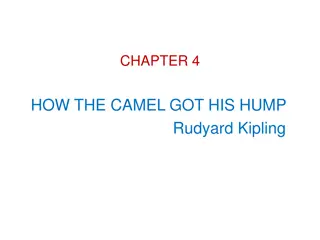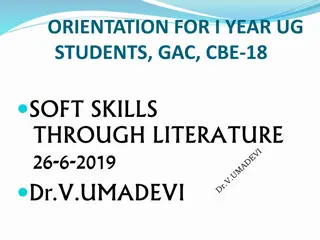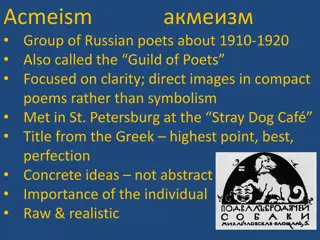The Camel Who Got His Hump - Rudyard Kipling's Story
This chapter explores how the lazy camel in the desert refused to work and was punished by a wise old man and a powerful Djinn. The story delves into the early days of animals working for humans, focusing on the camel's idleness and eventual consequences for his attitude.
0 views • 6 slides
Exploring Soft Skills Through Literature: A Path to Personal Development
Soft skills encompass a blend of personality traits, communication proficiency, and positive attitudes that set individuals apart. Originating in the US Army in 1972, soft skills include time management, teamwork, and confidence. Developing soft skills helps individuals excel in problem-solving, tea
0 views • 19 slides
Character Visualization Techniques in Literature
Rudyard Kipling, in "The Jungle Book," masterfully describes Bagheera, the Black Panther, using vivid imagery to help readers visualize him. The author paints Bagheera as inky black with panther markings that shimmer like watered silk in certain lights. Known for his cunning nature, Bagheera's soft
3 views • 10 slides
Acmeism: Russian Poetry Movement of 1910-1920
The Acmeism movement, also known as the Guild of Poets, was a group of Russian poets active from 1910 to 1920. They emphasized clarity and direct imagery in concise poems rather than symbolism. Meeting at the Stray Dog Café in St. Petersburg, the poets focused on concrete ideas over abstract concep
0 views • 7 slides
Brave Italian Soldiers in Rudyard Kipling's "The War in the Mountains
The novel "The War in the Mountains" by Rudyard Kipling delves into the experiences of Italian soldiers on the Italian front during WWI. Through vivid narration and rhetorical techniques, Kipling highlights the resilience, adaptability, and cooperative spirit of the Italian soldiers as they face cha
0 views • 9 slides
Analyzing the Soldier Depiction in R. Kipling's "The War in the Mountains
Explore the portrayal of soldiers in R. Kipling's reports on the war in the mountains during WWI. Compare the English and Italian versions, delving into the text's language, narrative technique, and structure to understand the differences and effects. Uncover the significance of the setting, text ty
0 views • 19 slides





